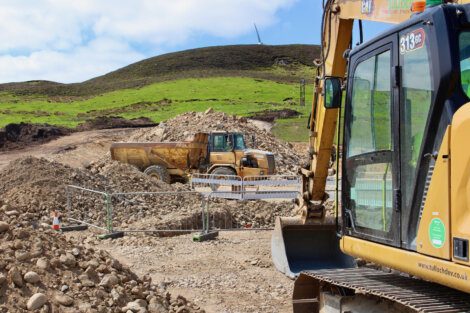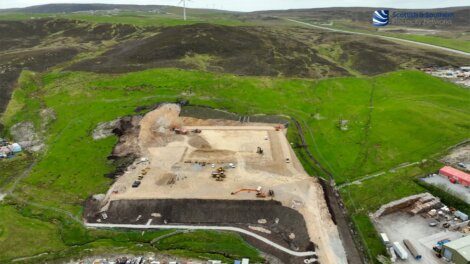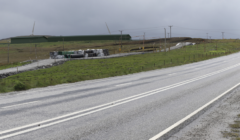Energy / Work well underway on new grid supply site in Lerwick
WORK is progressing on the ground in Lerwick on a site which will host key infrastructure needed to connect Shetland to the national grid for the first time.
Ground work is well underway at the site behind the Ocean Kinetics building in Lerwick on SSEN’s grid supply point project.
Taking everything into account, including a proposed battery storage standby solution which will be adjacent to the site, the project represents a £100 million investment from SSEN.
The grid supply point will ultimately enable Shetland’s energy needs to be met by the isles’ future new set-up, which will involve local wind generation as well as the prospect of power being sent north from the UK mainland’s national grid via a new subsea cable if needs be.
The distribution and transmission networks will be connected at a new substation – the grid supply point.
Project manager Mark Kelly said the plan is for the site to be energised in summer of 2025.
“This is a really interesting project for us and a really important project for us,” he said at the site on Thursday.
“This is about us securing supplies on Shetland and building a safe and resilient network. This will be the point where the transmission network meets the distribution network for the first time on Shetland, and then that will allow the network to connect to the GB mainland electricity network similarly for the first time, and that will be a massive step forward in terms of the resilience of the network on Shetland.”
Tulloch Developments is the main contractor on site and the company has around 20 people working there. SSEN Transmission is planning to have an office/operational building on site once it is completed.
Become a member of Shetland News
Work is progressing on the 600MW HVDC subsea cable which will connect Shetland – via Weisdale Voe – to the national grid on the mainland at Caithness.
It will allow the Viking Energy wind farm to export power, but it will also mean supply can come up to Shetland. Both of those projects are due to go live in 2024.
The diesel-powered Lerwick Power Station was built in 1953 and is approaching the end of its full-duty operational life.
The 72.8MW station provides around 50 per cent of Shetland’s electricity on an annual basis, with the gas-fired Sullom Voe Terminal power station meeting around 30 per cent of demand. Wind and tidal renewables currently provide around 20 per cent of the isles’ supply.
When the Lerwick station goes into standby – which is expected to be for a ten-year period – it will be called upon if there is an outage on the subsea cable.
But that process will take up to an hour, and that is why a battery storage system is being procured by SSE to “keep the lights on” during that time.
Energy companies Statkraft and Zenobe are both bidding for the contract, which should be awarded later this summer.
There have been concerns from some local residents about the safety of a battery storage system, particularly around fire.
But Kelly said providing a safe solution would be part of SSEN’s procurement process.
“The people that we’re procuring this from are major players in the battery market and in the energy services market, so they would be making sure that they have a robust safety case for the use of battery, and they are doing that in other main areas in the UK, so they really are experts in their field,” he said.
Become a member of Shetland News
Shetland News is asking its many readers to consider paying for membership to get additional features and services: -
- Remove non-local ads;
- Bookmark posts to read later;
- Exclusive curated weekly newsletter;
- Hide membership messages;
- Comments open for discussion.
If you appreciate what we do and feel strongly about impartial local journalism, then please become a member of Shetland News by either making a single payment, or setting up a monthly, quarterly or yearly subscription.


















































































